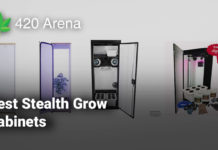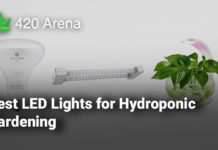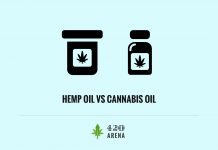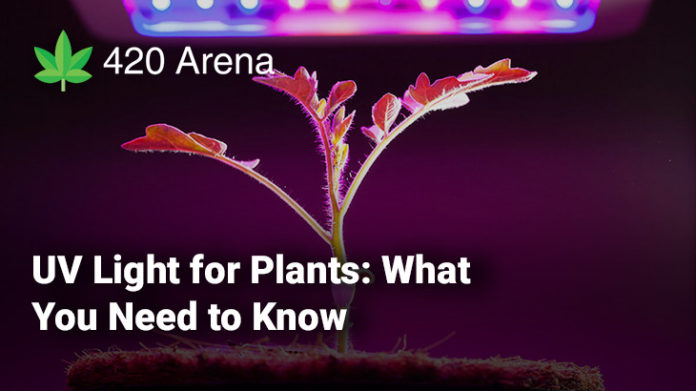Setting up the lighting system for your plants is fairly easy and there are thousands of websites and web pages which talk about it. However, when it comes to growing marijuana, there is one specific kind of light which isn’t really talked about that much but has been in the public discourse of late for a different reason. We are talking about Ultraviolet light, which is also popularly known as UV light. In this article, we shall be addressing the role of UV light for plants.
We aim at providing you with a detailed understanding of everything that you need to know about UV lights: What these lights are, where they fall in the lighting spectrum and wavelength, what are the different kinds of UV lights, what are the advantages and disadvantages of UV light for plants, etc. Towards the end of the article, we shall also answer some frequently asked questions about UV lights which will help you get a clearer picture and help you understand these lights even better.
UV lights have entered day-to-day discourse with the covid-19 pandemic growing all over the world. These lights also play a crucial role in sanitation processes as they have antimicrobial properties. While the core focus of our article today is about UV lights for growing plants (and more so about marijuana plants), but we shall also touch upon how this light is beneficial for killing microbes. There are many misconceptions and mythologies that have been churned up about UV lights and as we proceed, we hope to bust some of these myths and enhance your understanding. Let us first talk about why do plants even require light:
Why Do Marijuana Plants Need Light?
Like all plants, marijuana plants also require light to grow taller, stronger, bigger – or even to grow at all! Light is essential for growing weed because it helps the plants prepare their food via the process of photosynthesis. This is the process using which the plants convert sunlight into energy which helps them break down the sugars and other components and help the plants grow bigger and greener. Talking about greener plants, sunlight also helps the plants with the generation of chlorophyll, which is also quite an important element. Light also helps the plants with different things based on the color of light – some lights help foster the development of the stem or the root, while others are great for the leaves.
In the absence of sunlight, growers tend to make use of grow lights, which are quite a good replacement for those growers looking forward to recreating sunlight indoors. Grow lights combine lights of different spectral wavelengths to create a natural sunlight like light which is great for the growth of your marijuana plants. Most modern grow lights include a couple of bulbs dedicated to UV lights and IR lights.
Breaking Down the Spectrum and Wavelength of Light
In order to understand the role played by UV lights for plants, you need to understand what ‘light’ as we know it is composed of. In order to properly understand that, you will need to understand two concepts – wavelength of light and the visible spectrum. The sunlight that we see is in the form of rays. However, when you look at it very closely it is actually in the form of a wave with multiple crests and troughs. The distance between two consecutive troughs or two consecutive crests is known as ‘wavelength’.
Talking of the light that we see, it is a part of ‘the visible spectrum’, which ranges between the 380nm to 740nm range. UV light falls right before the visible spectrum begins. The visible spectrum comprises Violet, Blue, Green, Yellow, Orange, and Red lights. Each of these colors have their own properties and specific set of benefits for the plants.
What is Ultraviolet Light?
While the visible spectrum begins somewhere around 380nm with the violet light, 100nm to 380nm is where the Ultraviolet (UV) light lies. This light falls out of the visible spectrum and is hence invisible to the human eye although there are many animals who can actually see UV lights as well – giving them a whole different and unique view of the world which we will never be able to see. This brings us to the main topic of our discussion. Depending upon the level of UV light present in the light that the plants are getting, their characteristic features might differ. Especially when we talk about the cannabis plant, there’s so much that it benefits from this kind of light.
UV Light is basically an electromagnetic radiation and while there are a lot of myths and misinformation about it, the truth is that most of this light is harmful for humans! There are four different kinds of UV lights – UVA light, UVB light, UVC light and UVR light. The first two are the ones which are useful when it comes to growing plants while the other two are actually harmful for growing marijuana (or even to humans).
The UVA light lies between 320 to 400nm while the UVB light lies in the range of 290 to 320nm. More specifically, the UVA light is the best suited for marijuana plants as it helps them with many characteristic features such as their taste, and even the kind of ‘high’ that you get with it depends upon this light. Let us take a detailed look at the advantages and disadvantages of UV lights for growing plants:
Benefits of UV Light for Growing Marijuana Plants
While generally perceived as harmful for humans and for plants, there are actually quite a few benefits that these lights bring along. Here’s a closer look at the benefits of UV lights:
1. Increases The Production of Resins
The biggest benefit for marijuana growers is that using UV lights will help you boost the production of resins in your crop. The higher the exposure to UV lights, the more resins will be produced – resins, in turn, produce flavonoids and terpenes – which are the key compounds that provide your plant its unique flavour (with the help of flavonoids) and smell (with the help of terpenes). Too little or no exposure to UV lights would leave your plants with a not-so-strong taste or smell. Too much of these lights would make it too strong for some peoples’ taste. In addition to increasing resins, UV lights also help boost the production of certain oils in your marijuana plants.
2. Better Protection Against Pests and Insects
Resins are known for their protective properties for the plants. Resins help the plants survive against pests, insects, and pathogens. Resins help ‘repair’ your plant. Anyone who has grown weed knows that pests can pose a real threat! Aphids, or even smaller insects and pests can cause quite a nuisance and your entire plant can be affected because of them! Hence, this is an important aspect.
3. Increasing the Levels of THC and CBD
Growers and stoners alike know that when it comes to marijuana plant’s resins, there’s much more than regular protection and taste that they offer. Resins also contain THC and CBD (in small quantities) which add to the overall potency of the plant! The higher the resin content the better the quality of ‘high’ that you are going to get when you smoke that weed! Hence, when UV lights increase resins, they are also improving the levels of THC and CBD in your plants.
4. Improving Root Mass and Improves Branching
One of the key benefits of using UV lights is that they also help in promoting the overall growth and strength of the roots too. Especially while your plants are at a younger stage. Increasing root mass is very important. This is because growers often transplant their plants from one place to another when they start growing – In most cases it is outdoors to indoors and in some rare cases, it can also be indoors to outdoors. Hence, the roots really need to be well developed in order for this transplantation to successfully happen as they are the ones which bear the brunt of the stress. This is another aspect where UV lights are quite helpful. In addition to improving the root mass, UV lights also help improve branching and provide you with more branches which are better spaced out as well – giving you a higher yield overall!
Disadvantages of UV Lights for Plants
Now that we have examined what are the pros of growing your marijuana plants under UV lights, it is also critical to know what are some negative effects of growing your plants under these lights. The key to providing UV lights to plants is to provide it in limited quantities otherwise it might end up harming your plant more than it benefits it.
1. Bleaching
If your UV light is kept too close to your marijuana plants, or you are providing too much of it, you are bound to damage your plants. One of the first signs of damage happens in the form of ‘bleaching’ where your plants begin to get discolored and are essentially damaged. In a marijuana plant you could see them losing color – and that happens quite rapidly. What happens with bleaching is that the bleached portions of your plants can no longer take in light and hence wither away and die! This is something you need to watch out for.
2. Damage to Cells, Lipids, DNA
If provided in large quantities, UV lights can actually damage your plants – especially the cells and lipids – and the damage can also reach the plant on a DNA level. Overexposure can also damage other similar aspects such as the flavonoids and terpenes – which will develop too strong a taste and flavor and will not be fit for consumption as most growers wont prefer smoking them!
Effects of UV Lights on Humans
Exposure to UV lights for humans can begin to show signs of excessive suntan or sunburn. However, prolonged exposure to these lights can cause more dangerous ailments such as skin cancer. However, the UVB rays from the sun also have a beneficial effect on humans when they get them in smaller amounts – helping develop Vitamin D, which is very important. In fact, not just humans, most land animals get Vitamin D from this light. Vitamin D generates serotonin which is also responsible for the overall happiness of an individual.
Exposure to UV lights at 265–275 nm is quite dangerous for the human eye and it can even lead to ailments such as cataracts. It is extremely important for humans to wear protective glasses while working with UV lights.
Effects of UV Lights on Microbes
UV lights have been extremely important when it comes to dealing with bacterias and microbes. Especially at a time when the world is dealing with a pandemic, UV lights are being used widely for sanitation purposes. UV lights for plants are important, but in sanitation, they help kill microbes. However, there are pros and cons to this as well – not all bacteria are bad as there are some bacteria which might beneficial for the growth of your plants as well and they too die along with the bad bacteria. There are some bacteria which provide Nitrogen to the plants and if those are killed off plants might face a deficiency of Nitrogen levels! Hence, it needs to be used carefully as it is a double-edged sword.
What are Black Lights?
There are a large number of sources which act as an artificial source of Ultraviolet lights. These include short wave UV lamps, UV lasers, UV LEDs, Gas-discharge based UV lamps, Incandescent UV Lamps – but one of the most popular means of getting artificial UV lighting is by using “black lights”. However, growers need to know that black lights emit only UVA lights, which isn’t really something that you want your plants to grow under. Most plants will not grow if black light is the only source of lighting that they are getting. However, if you use very small quantities of it and keep it at an appropriate distance from the plants while using this light with other regular sources of lighting then it can be of some benefit as a source of UV lighting for your plants.
Frequently Asked Questions About UV Lights for Plants
Here are the answers to some of the most popular questions that we get asked about UV lights. Do go through them once as you might have a similar question in your minds too!
1. Does UV Light Cause Cancer?
Exposure to a lot of UV lights coming from natural sources or from really strong artificial sources can cause skin cancer.
2. Can UV Lights Help in Sanitizing Things?
Yes, UV lights have antimicrobial properties which are great when it comes to sanitizing things. It is because of this property that these lights have become especially popular in sanitation purposes during the COVID-19 pandemic.
3. How Are UV Lights Beneficial for Plants?
When it comes to benefits, the UV lights help your plants improve their branching as well as improving on their root mass. For marijuana plants, UV lights are also critical for developing a proper taste and flavour, as well as for increasing the levels of THC and CBD.
Conclusion
In conclusion, we would like to say that UV lights are something that growers need to deal with very carefully. Getting a grow light which has a couple of LEDs dedicated to UV lights are the best way to provide UV lights to your plants as they need to be provided in just the right combination – a little too much or a little too less of UV lights can cause alterations to your plants which you might not prefer! If there are still any more questions, feel free to mail us or let us know in the comments section and we shall answer them as soon as we can! Till then…
Happy Growing! 🙂
Table of Contents

















![How to Use Carbon Filters in Your Grow Room [7 Best Carbon Filters for Grow Rooms in 2021] How to Use Carbon Filters in Your Grow Room](https://420arena.com/wp-content/uploads/2020/12/How-to-Use-Carbon-Filters-in-Your-Grow-Room-218x150.jpg)










